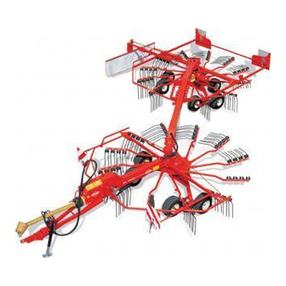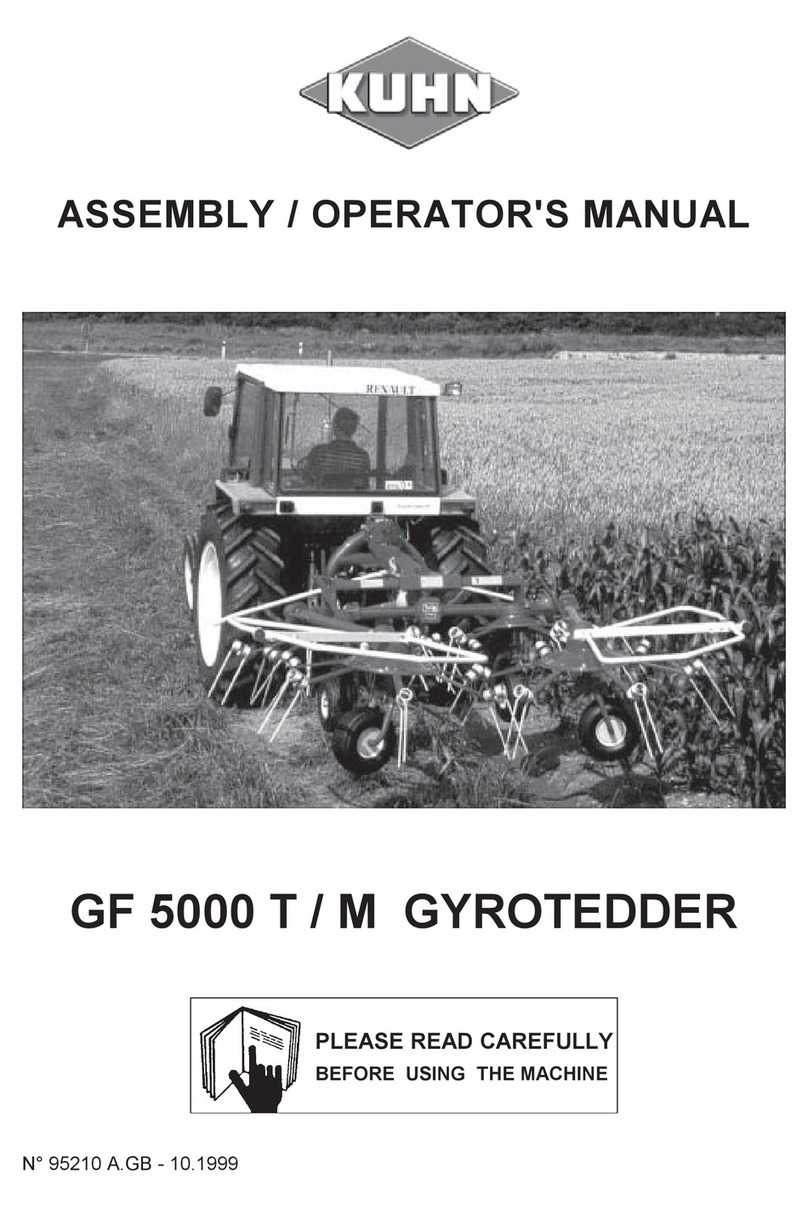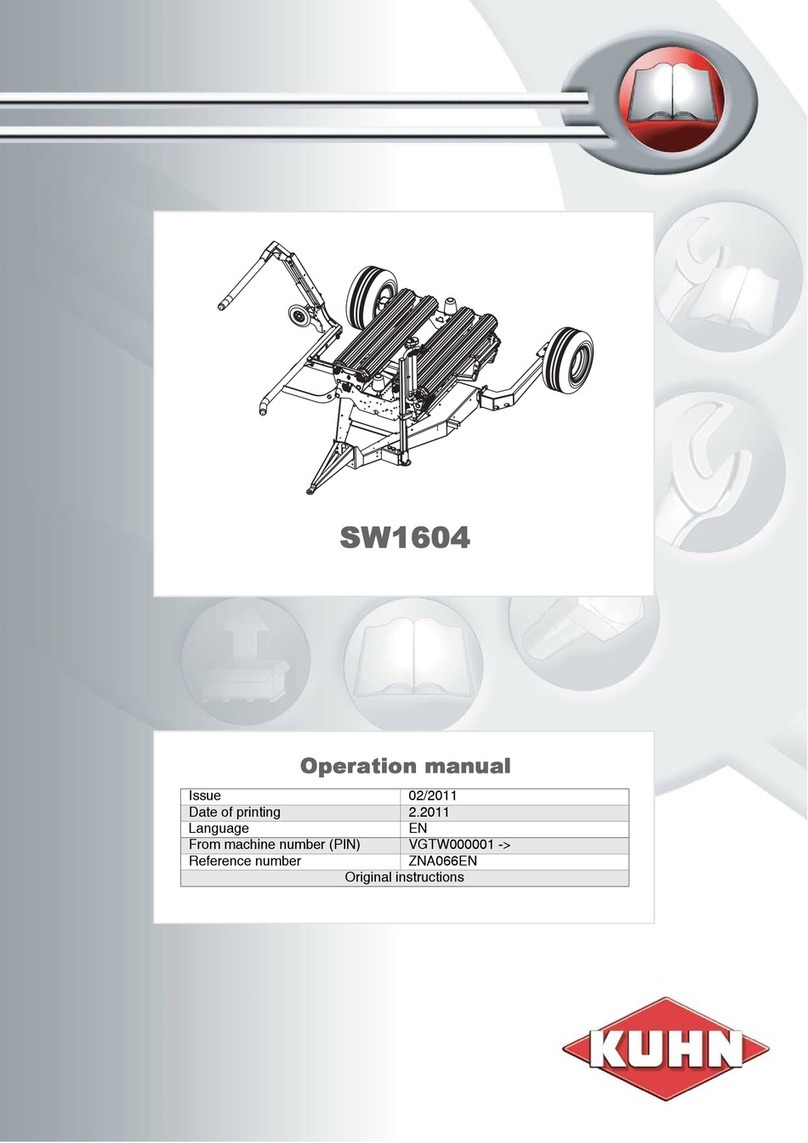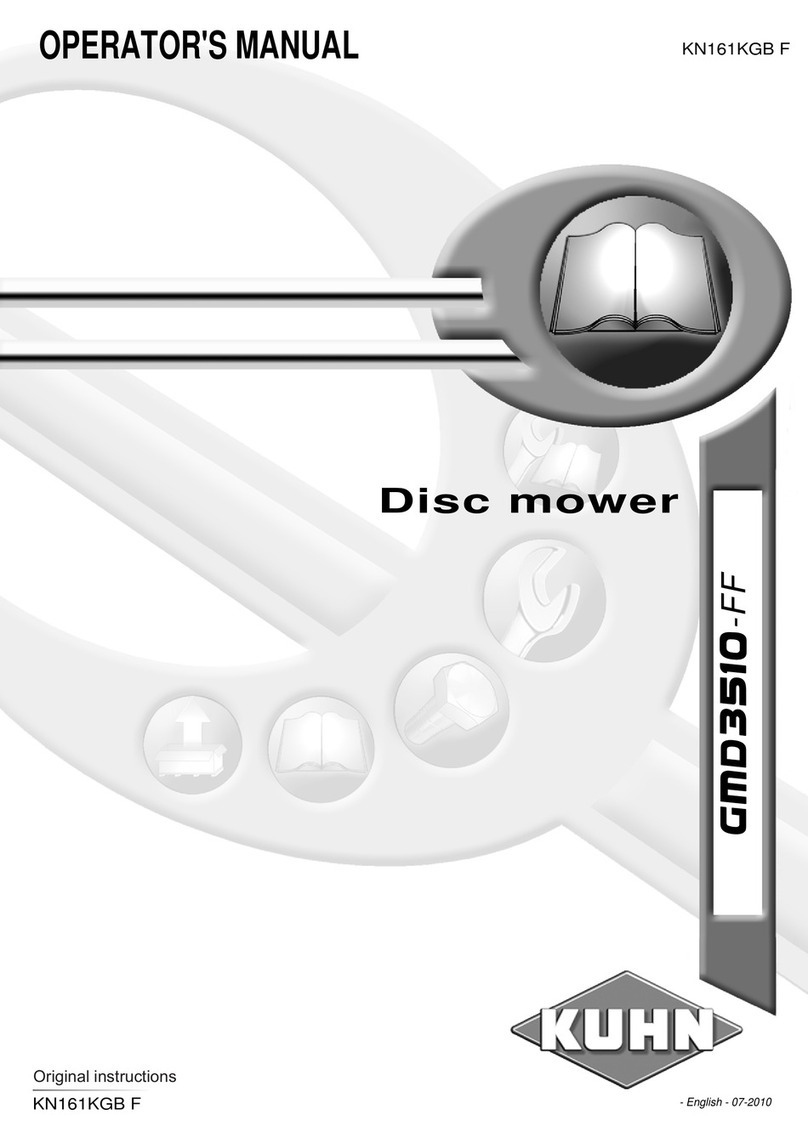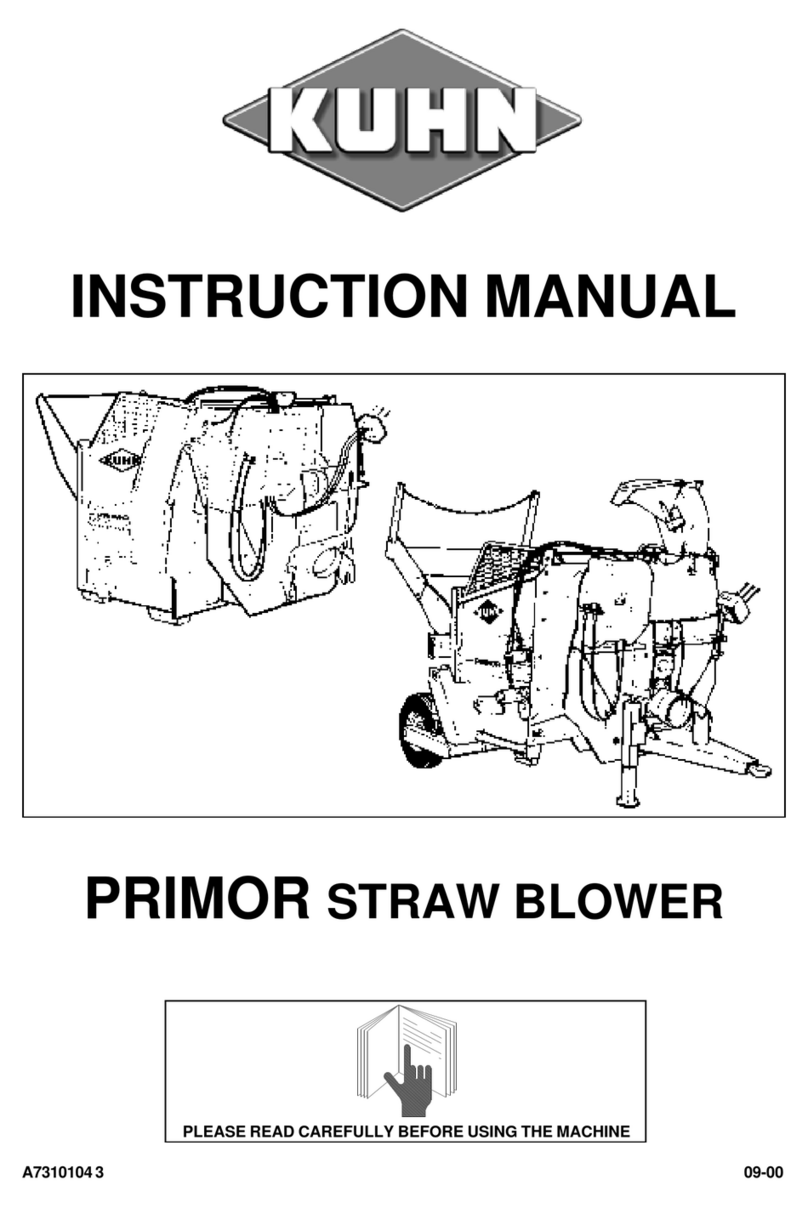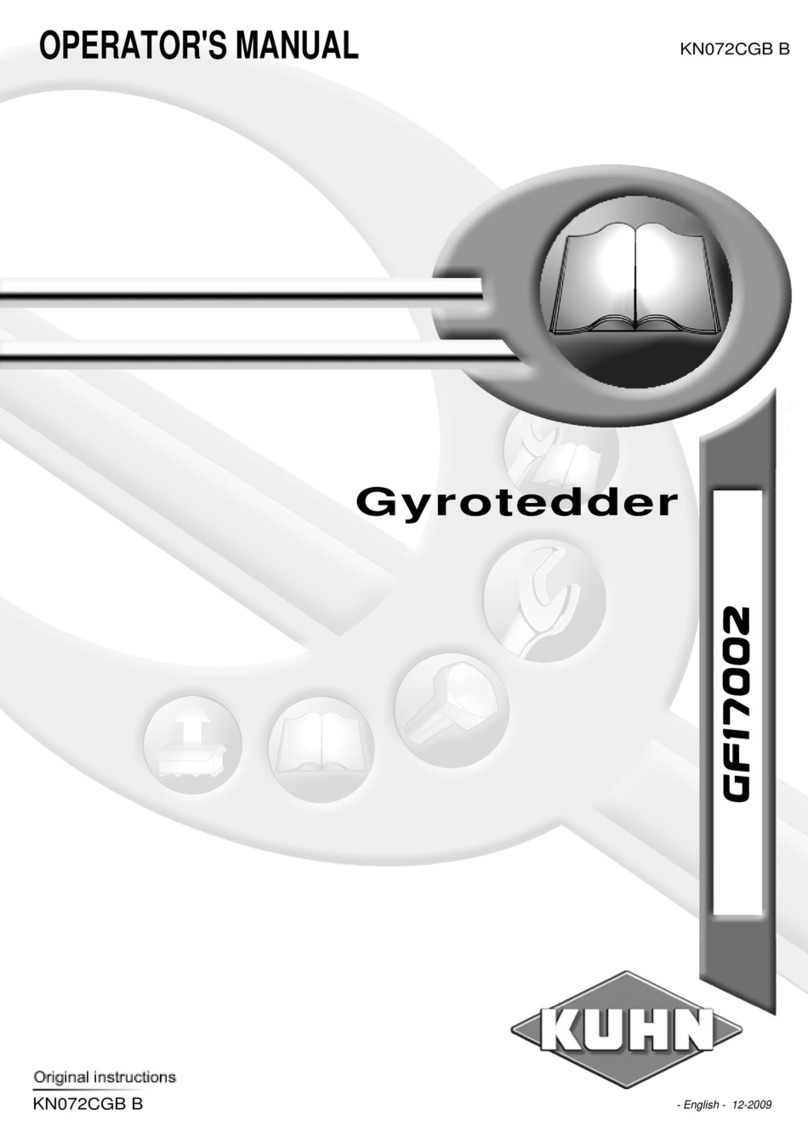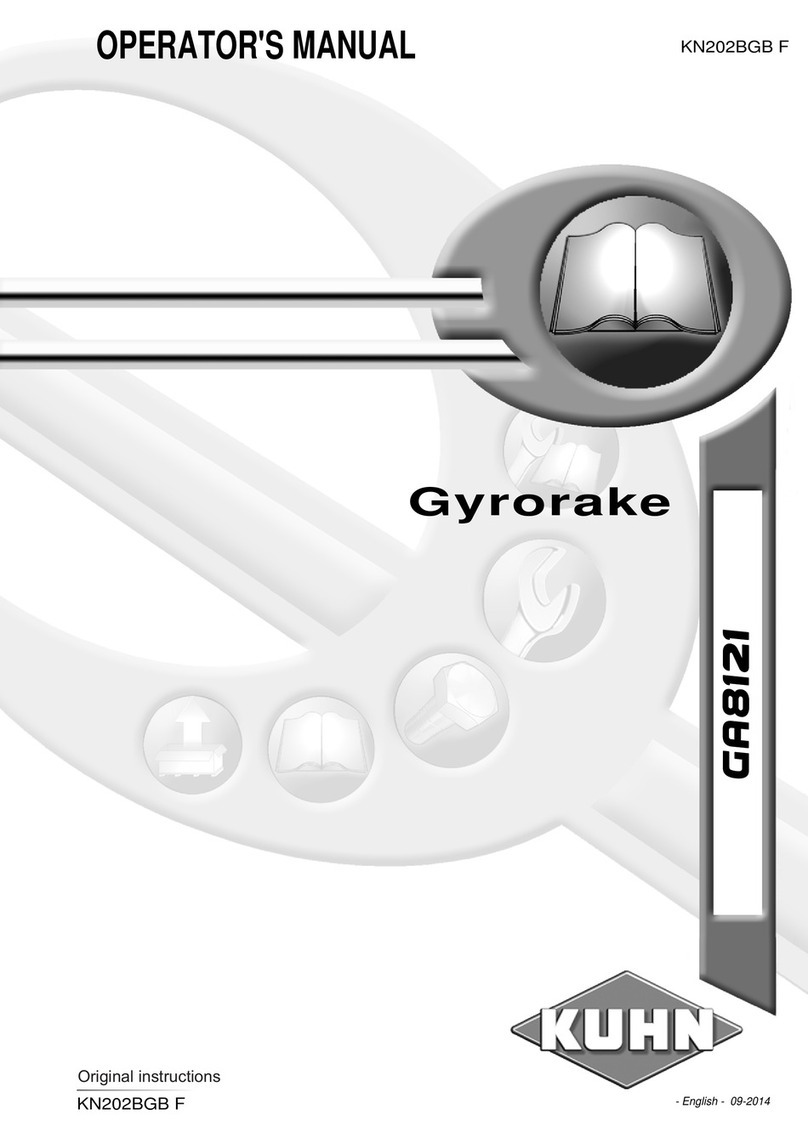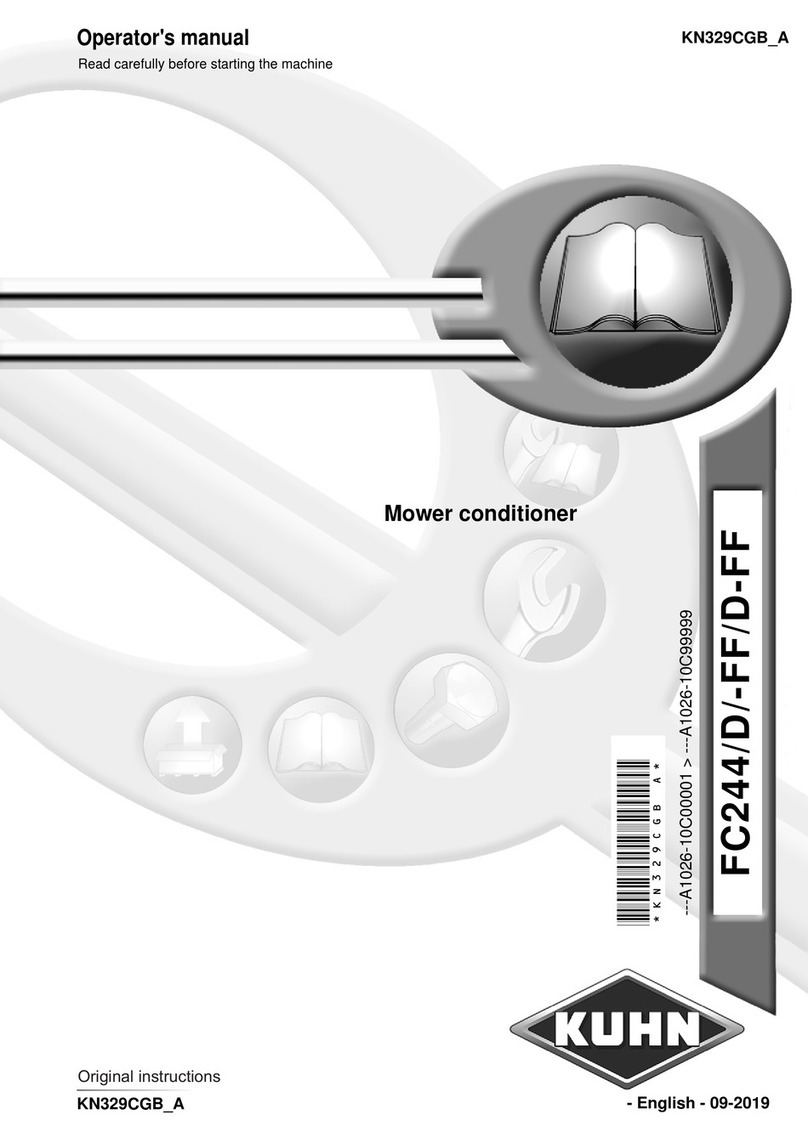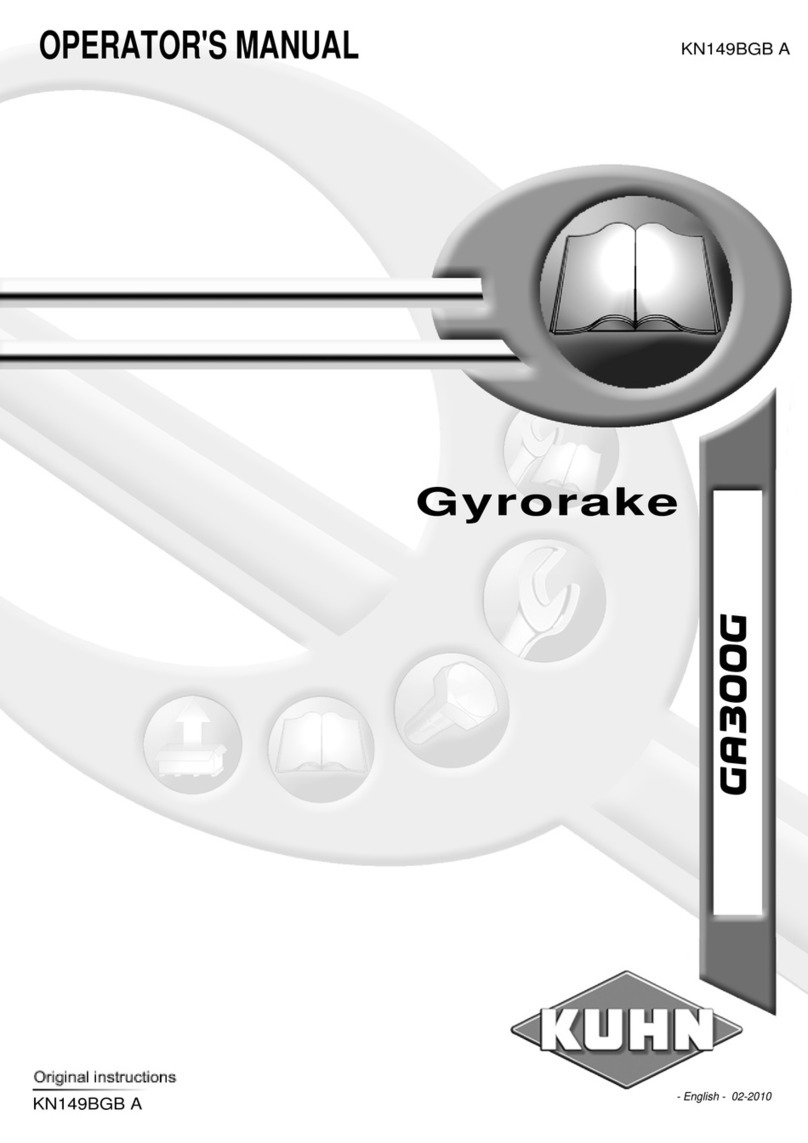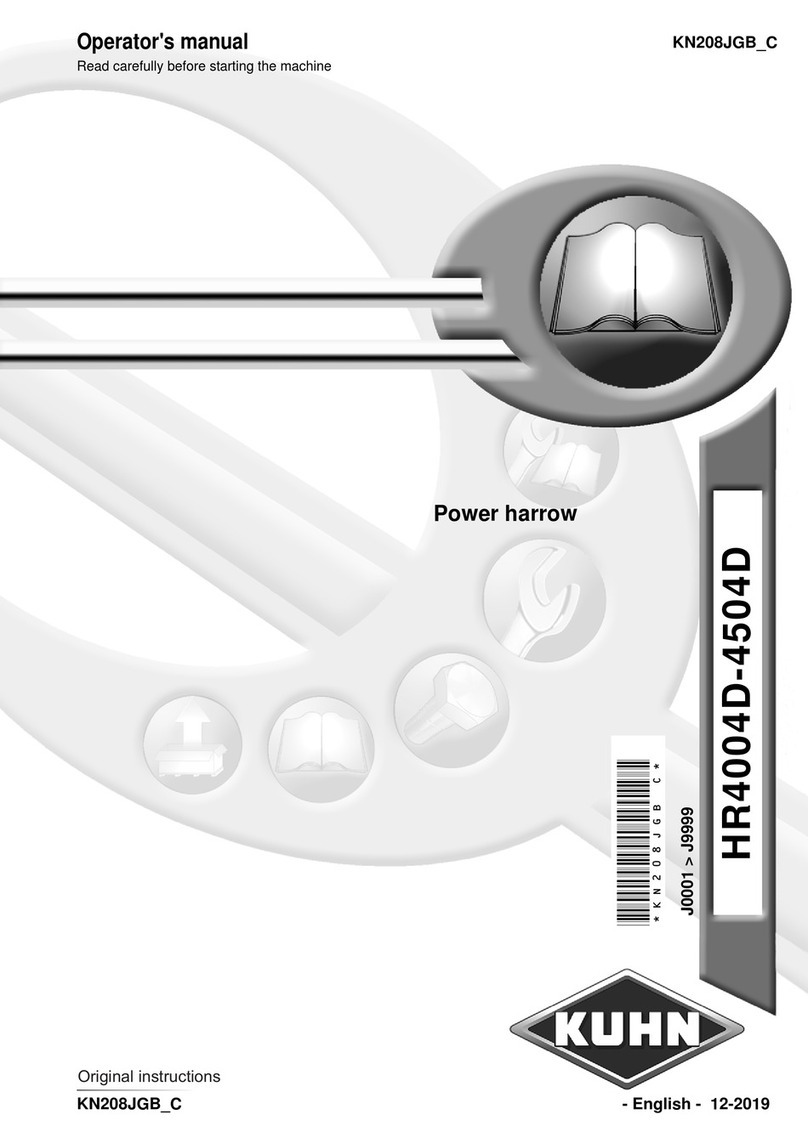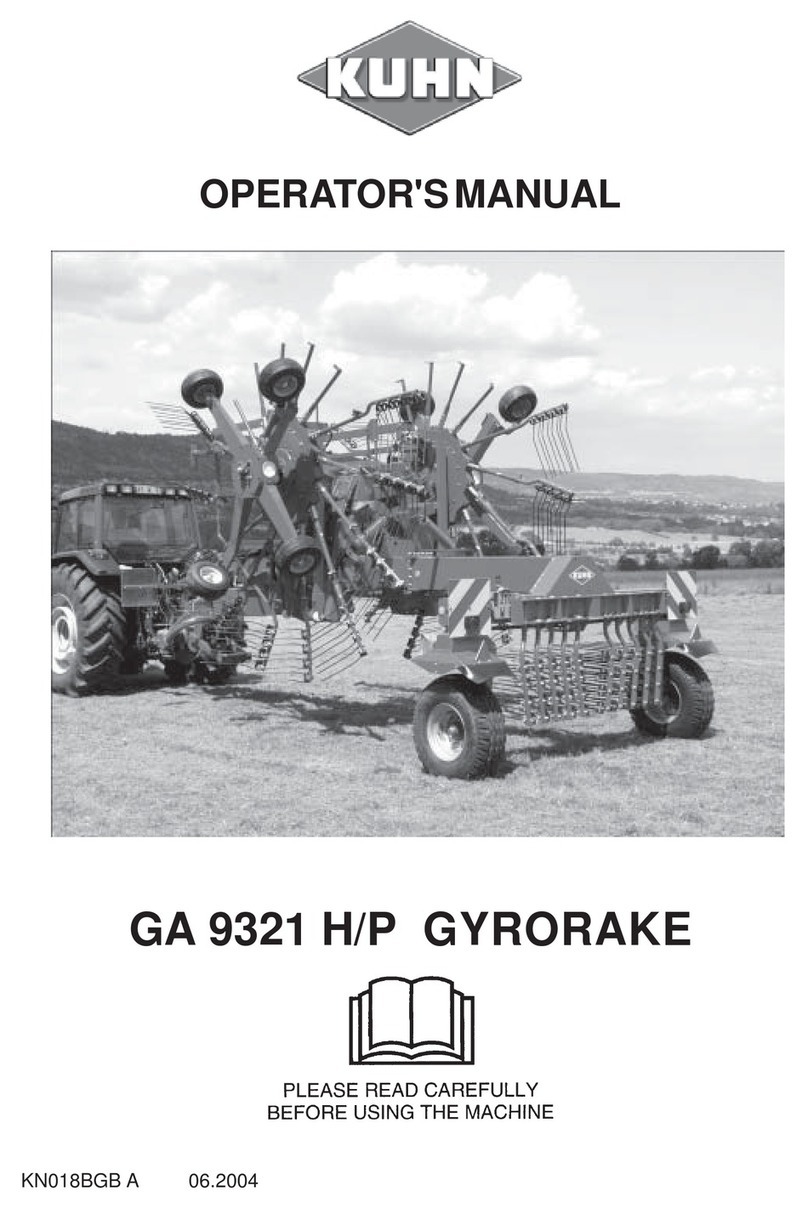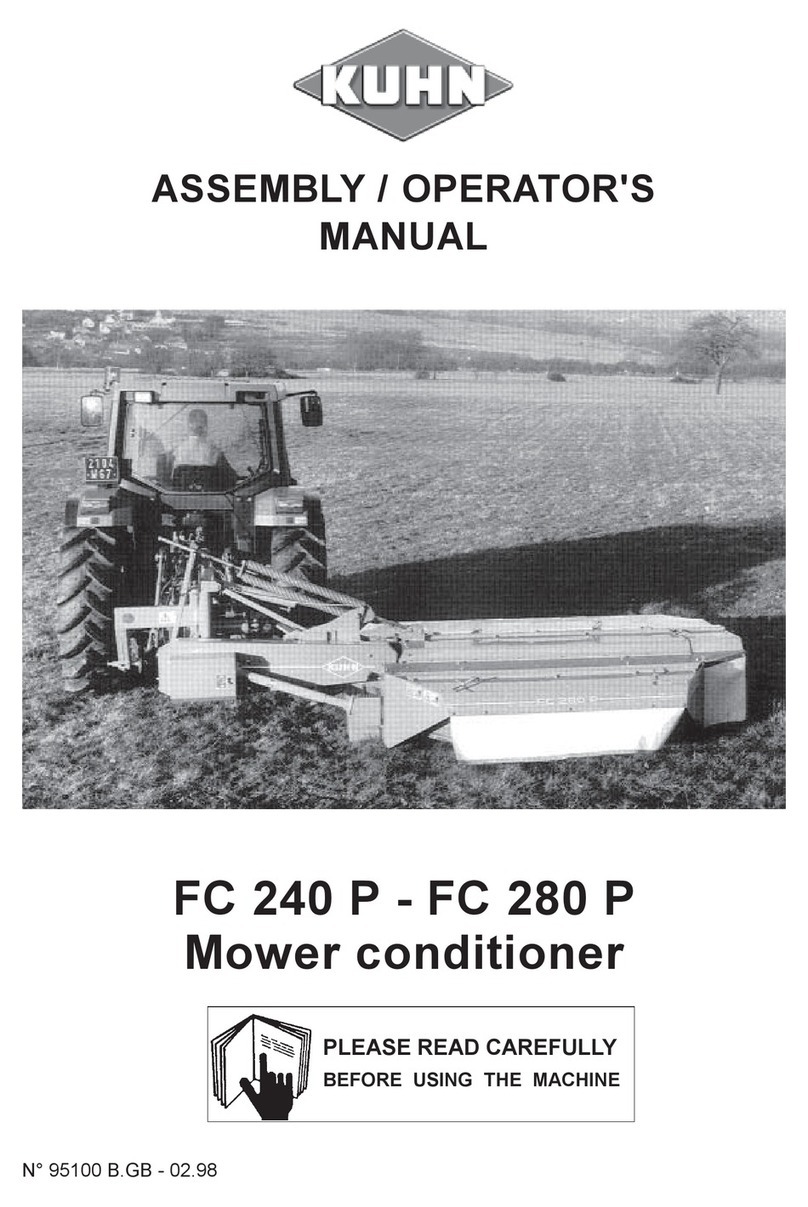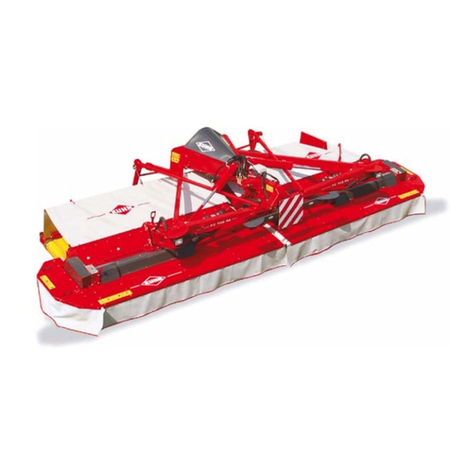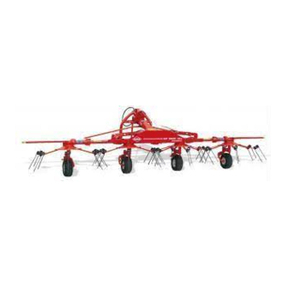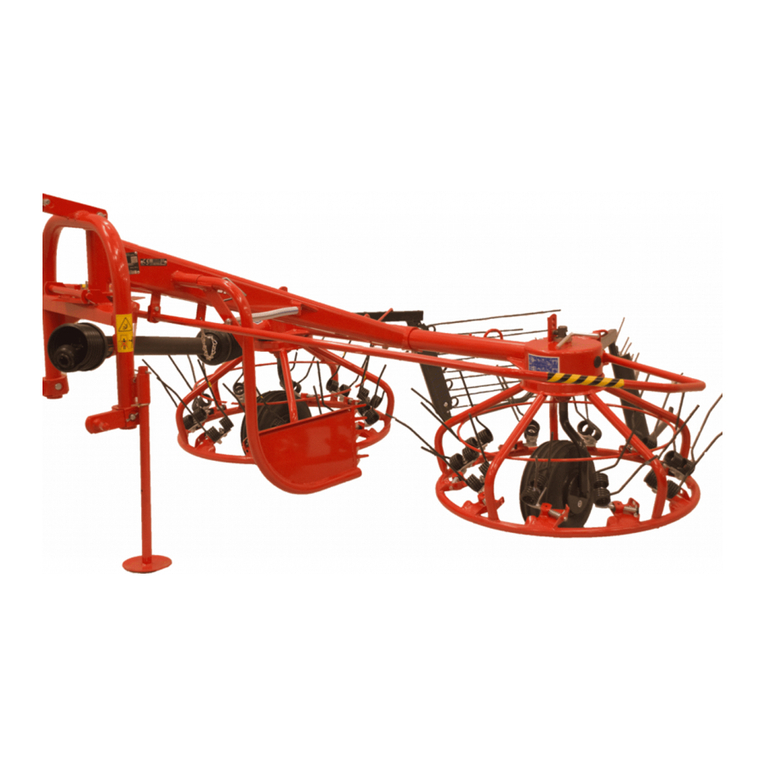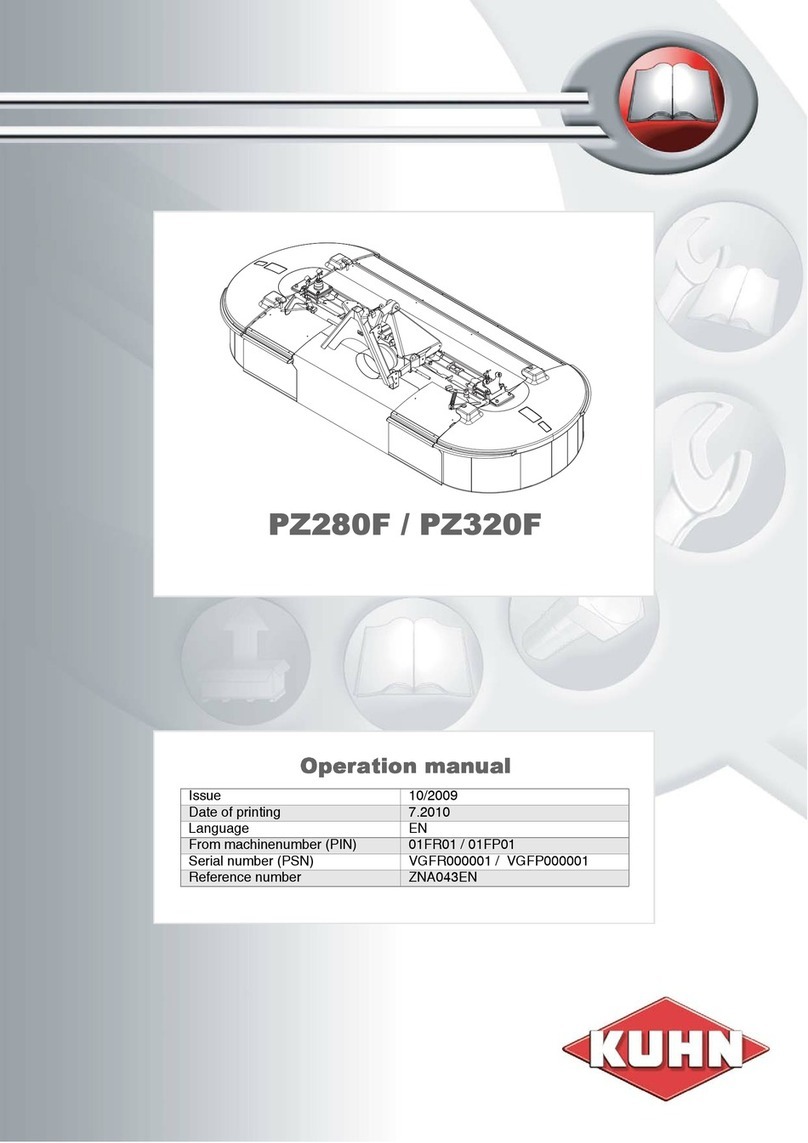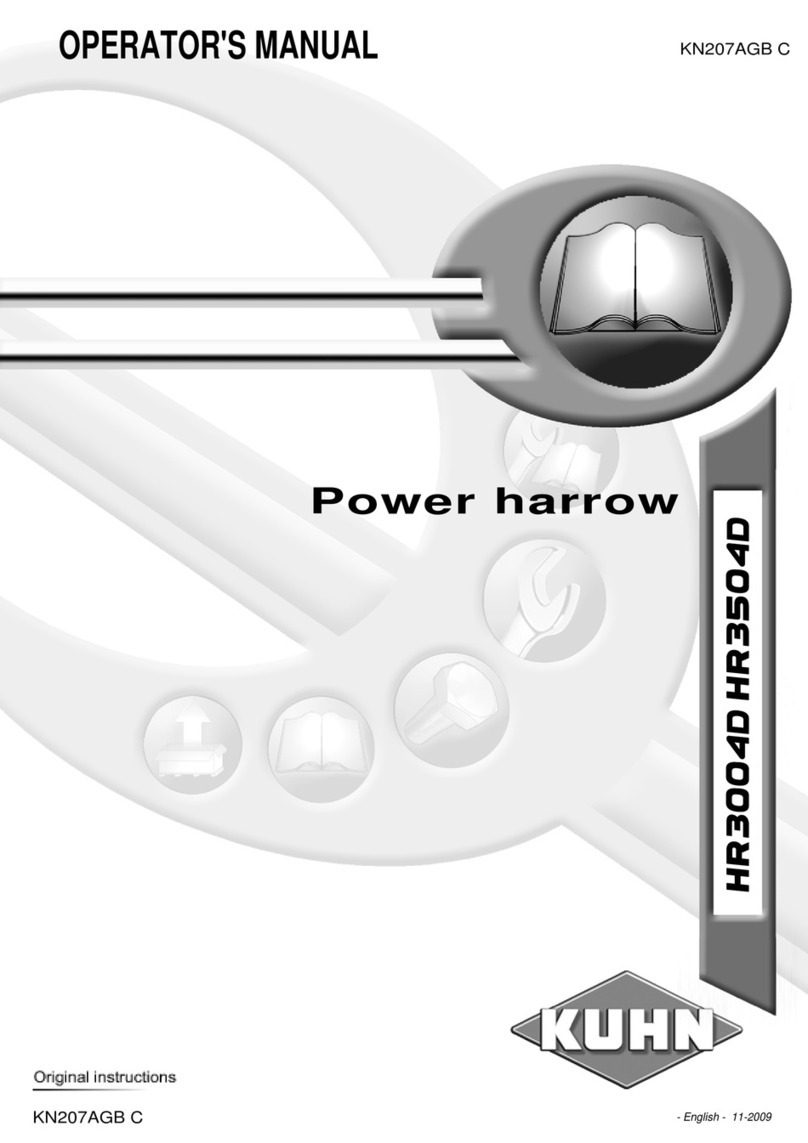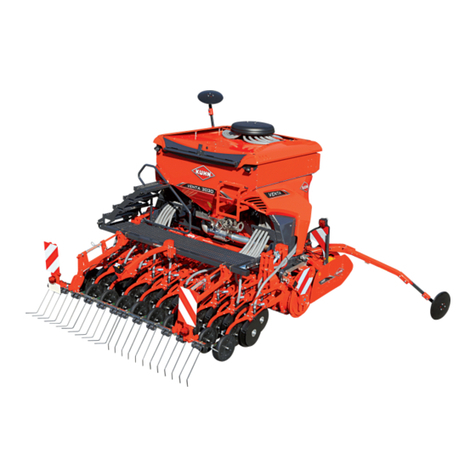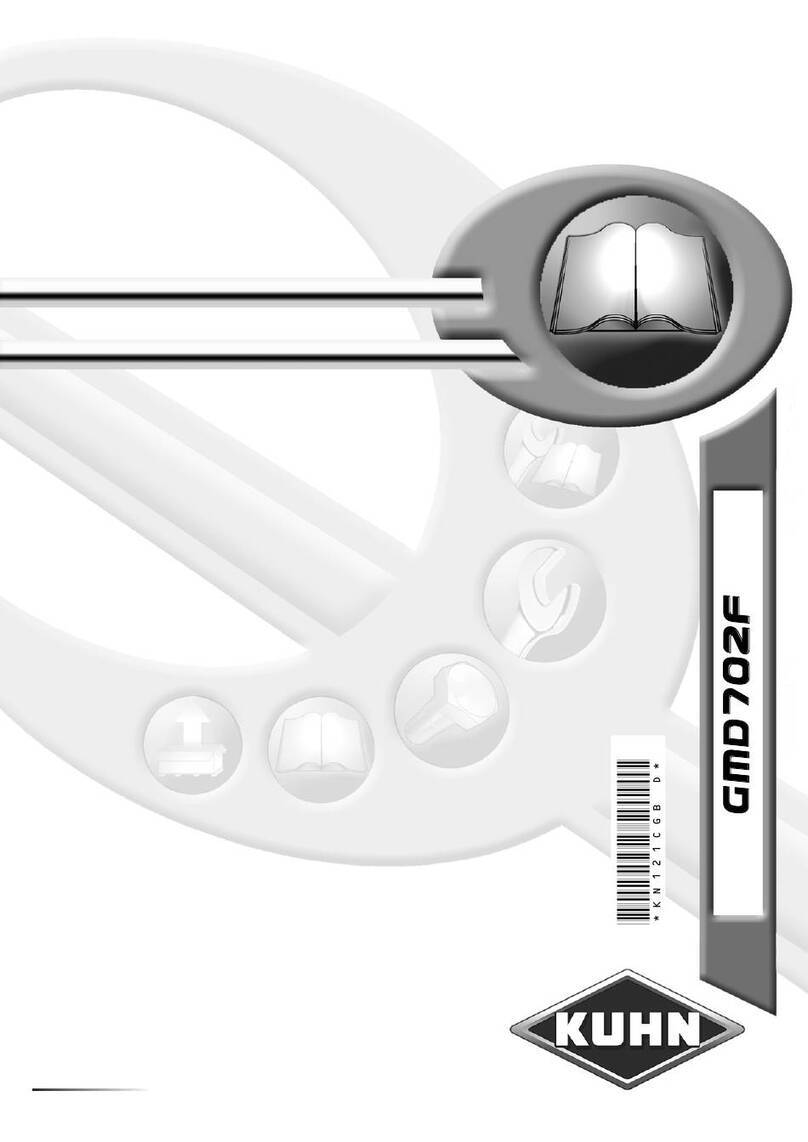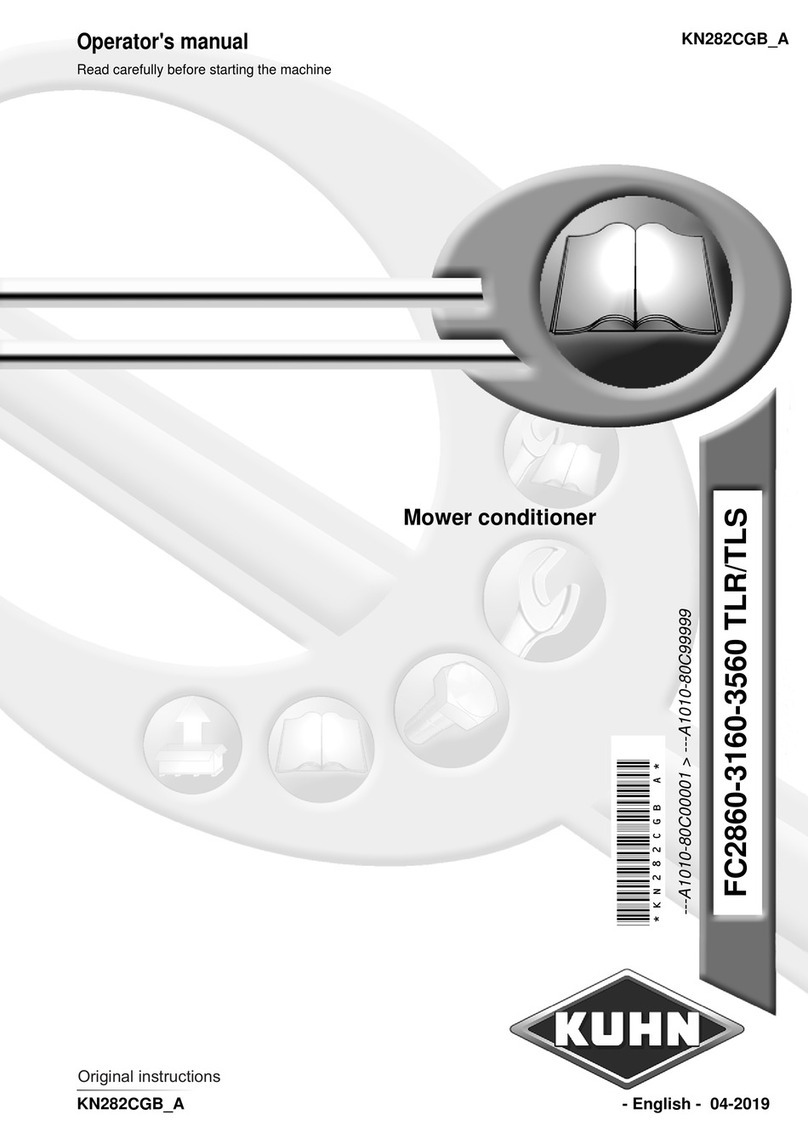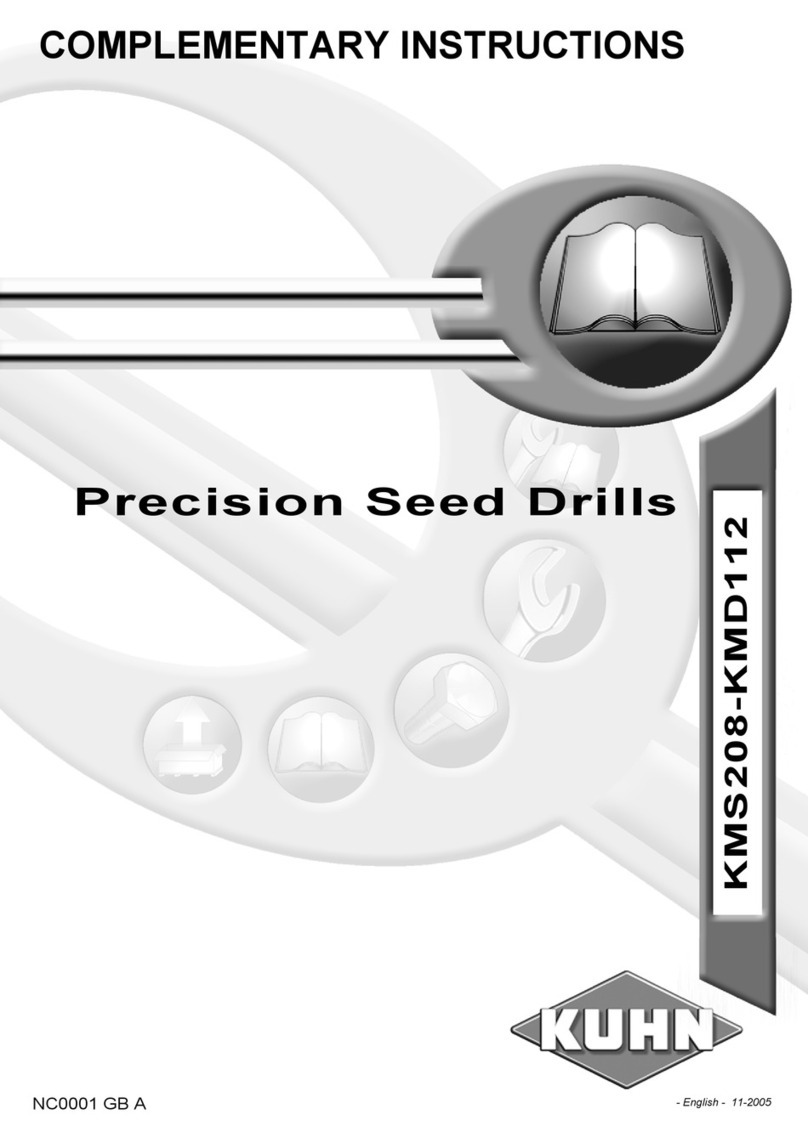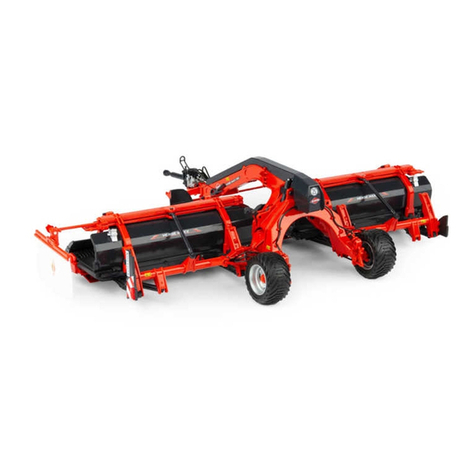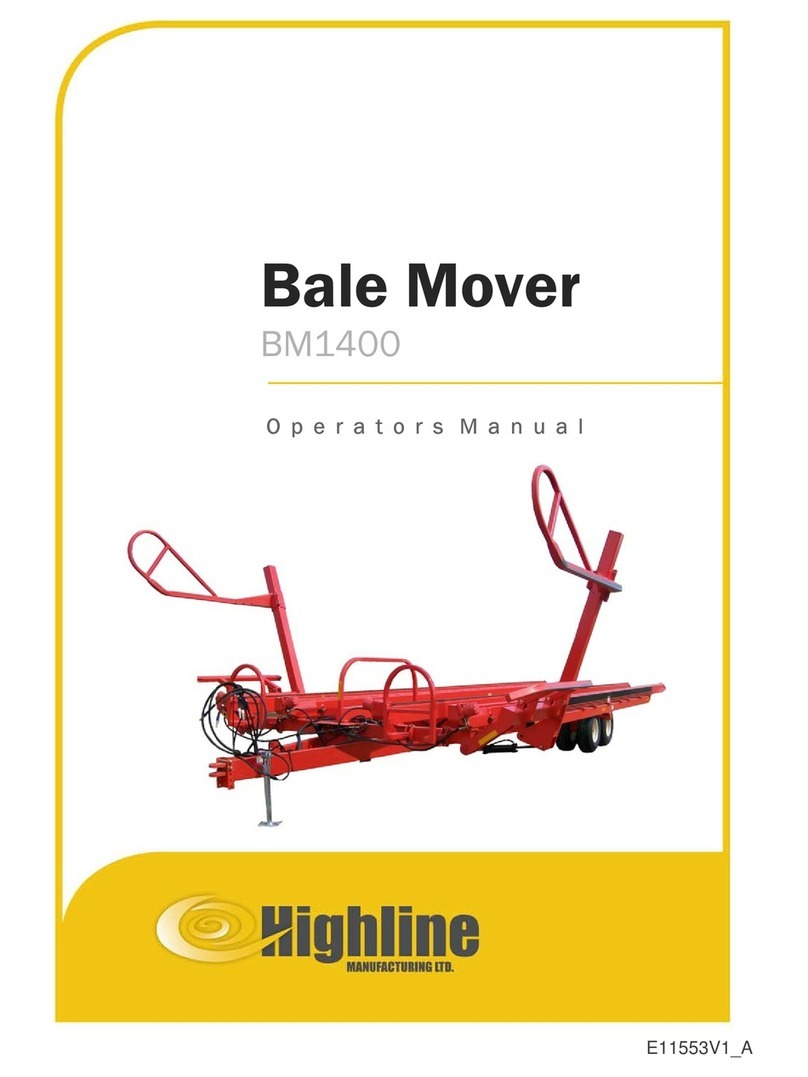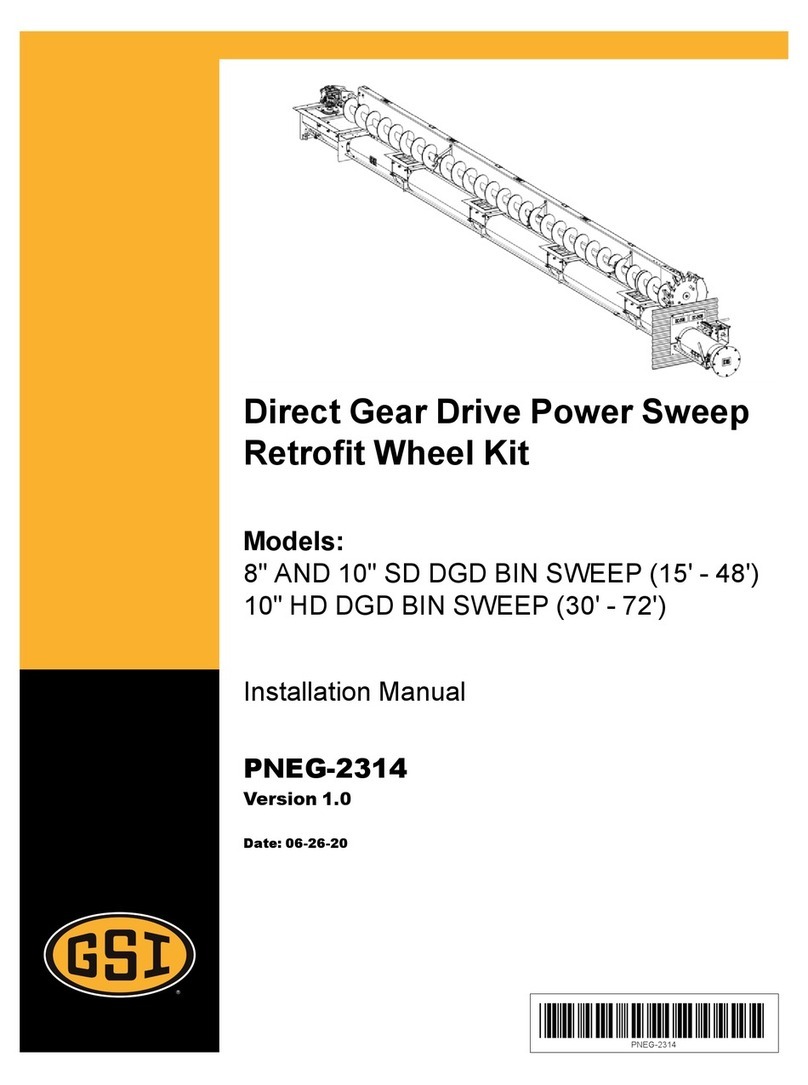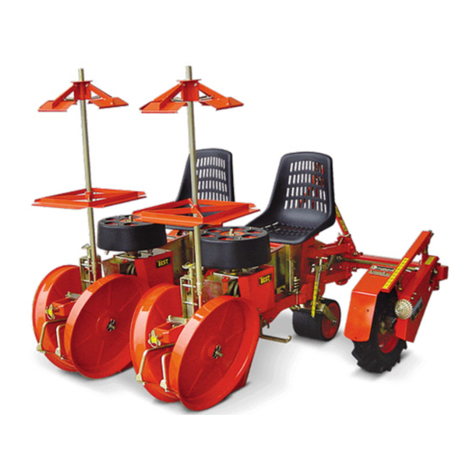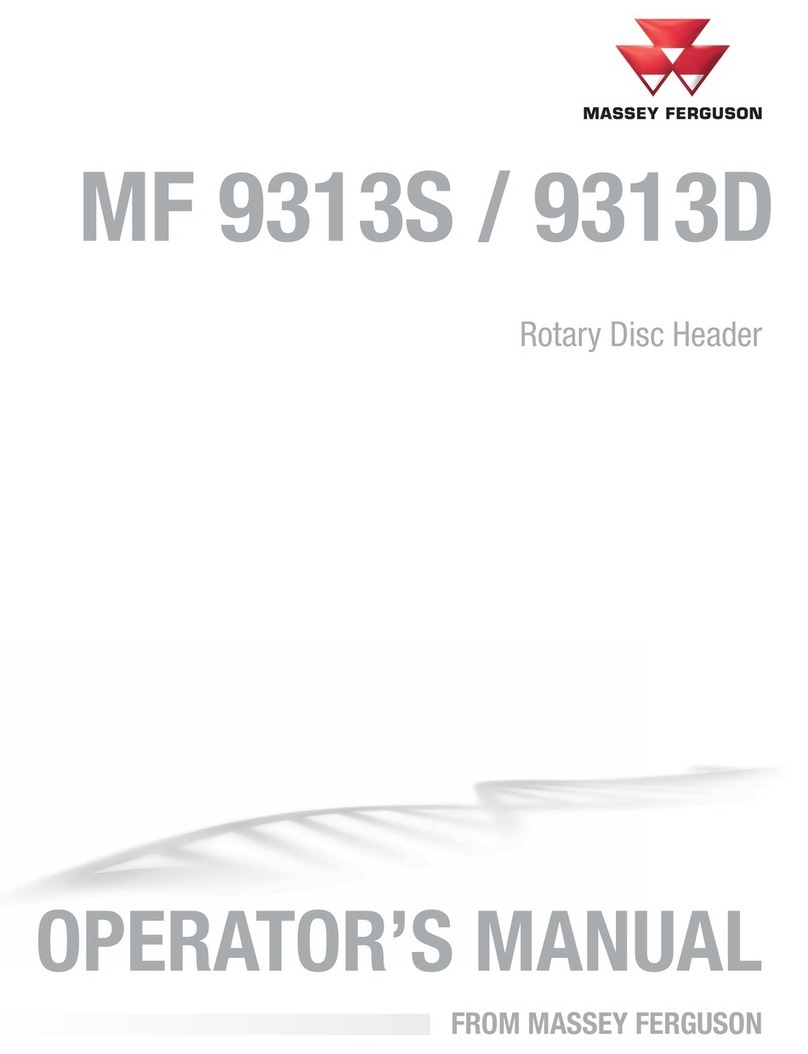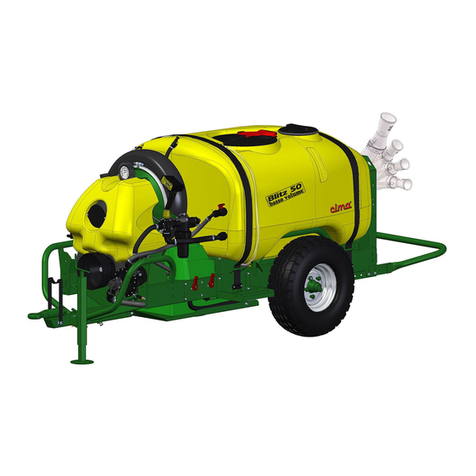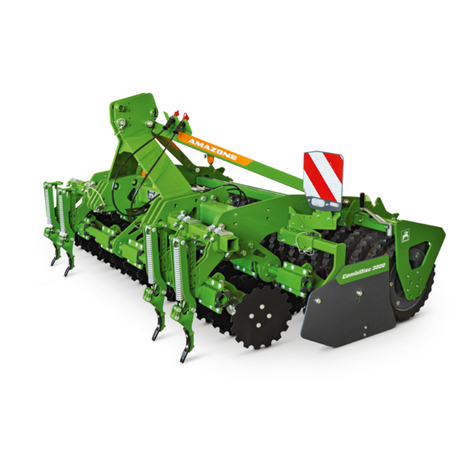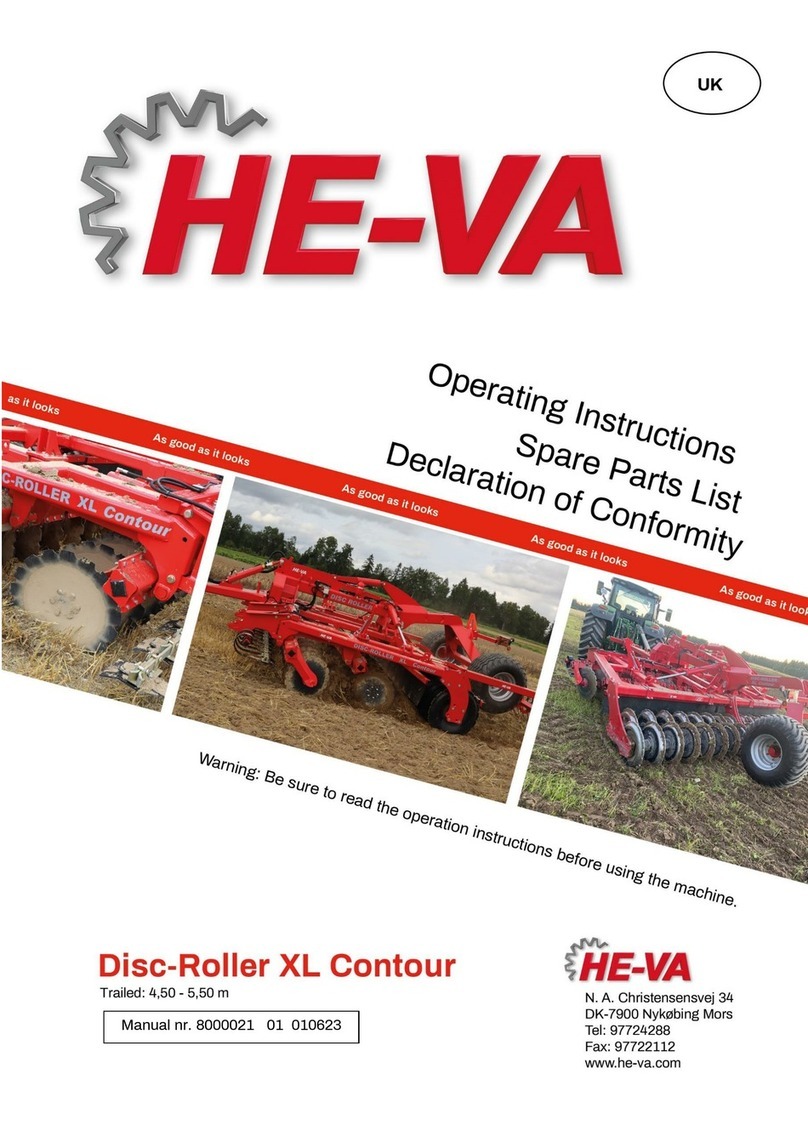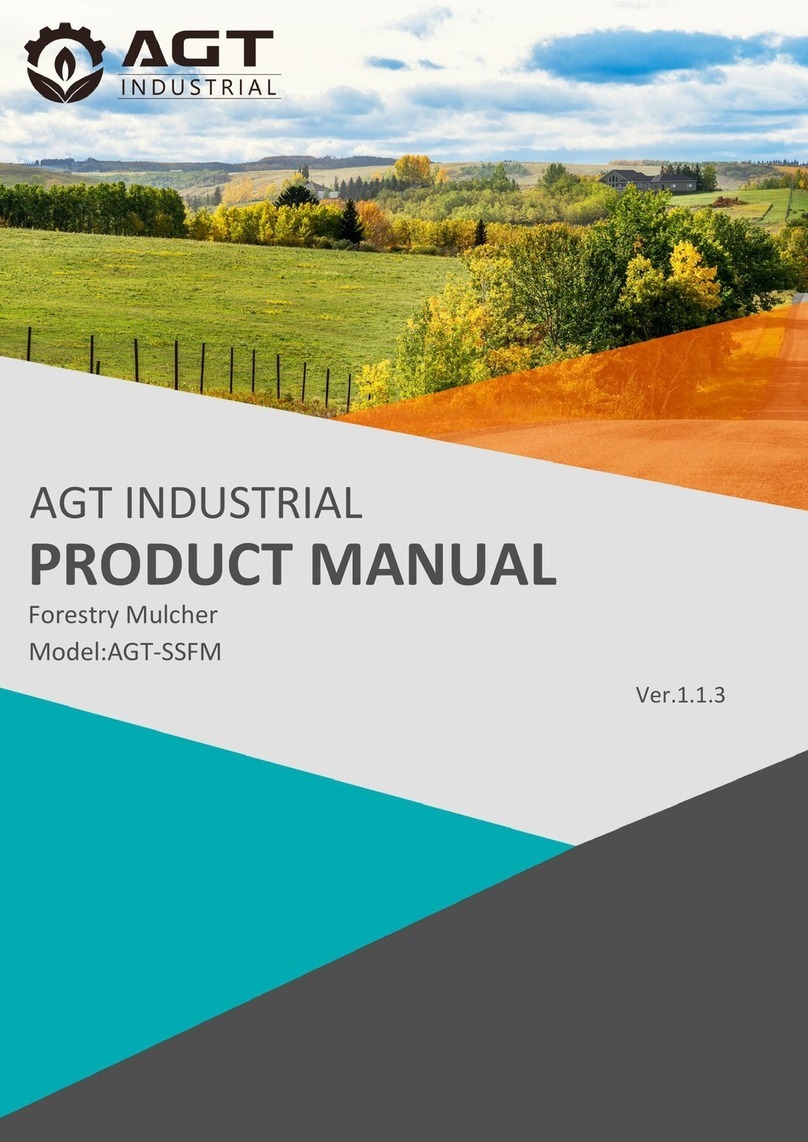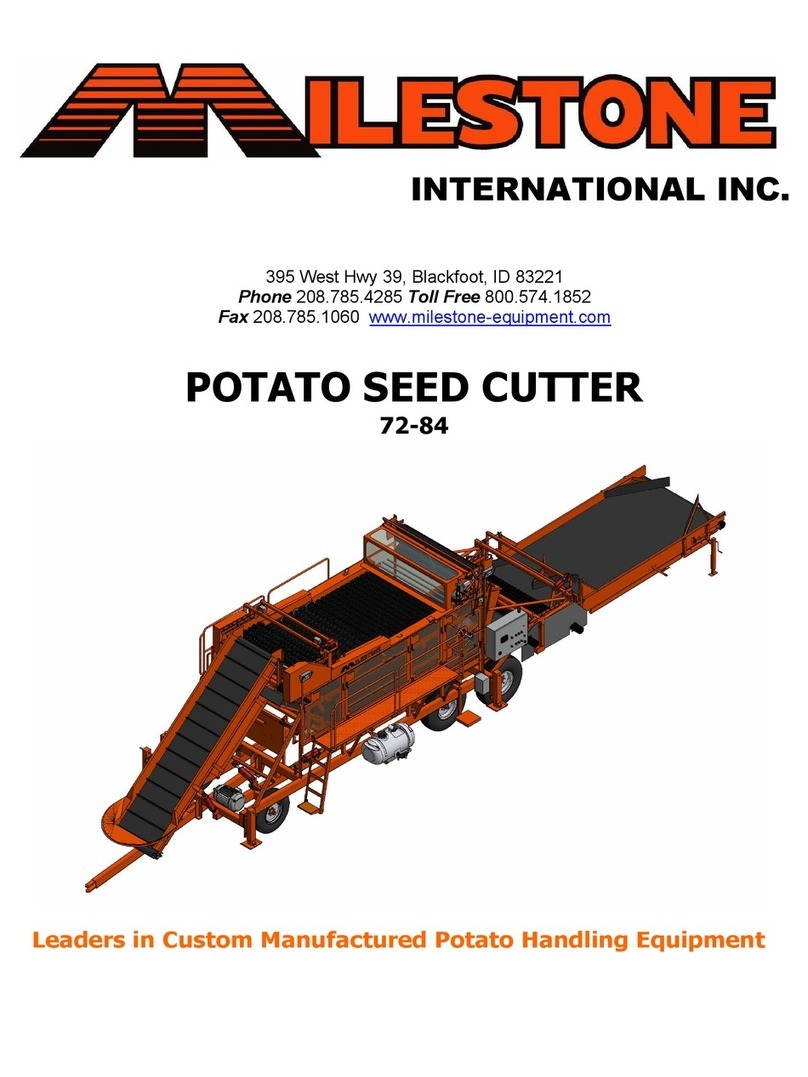KUHN GA 4511 GM User manual

ASSEMBLY / OPERATOR'S MANUAL
GA 4511 GM
GYRORAKE
N° 95314 B.GB - 07.98

DEAR OWNER,
In buying a KUHN machine you have chosen wisely. Into it have gone years of thought,
research and improvements. You will find, as have thousands of owners all over the world, that
you have the best that engineering skill and actual field testing can produce. You have
purchased a dependable machine, but only by proper care and operation can you expect to
receive the performance and long service built into it.
This manual contains all the necessary information for you to receive full efficiency from your
machine. The performance you get from this machine is largely dependant upon how well you
read and understand this manual and apply this knowledge. Please D N T ASSUME THAT
Y U KN W H W T PERATE AND MAINTAIN Y UR MACHINE before reading this
manual carefully. KEEP THIS MANUAL AVAILABLE F R REFERENCE.
Your KUHN dealer will instruct you on the general operation of your machine. He is interested
that you get the best performance possible and will be glad to answer any special questions
that may arise regarding the operation of the KUHN machine.
Your KUHN dealer can offer a complete line of genuine KUHN service parts.
These parts are manufactured and carefully inspected in the same factory that builds the
machine to assure high quality and accurate fitting of any necessary replacements.
When ordering service parts it is important that you indicate the type of machine concerned
and its serial number.
For this reason please complete the model identification plate diagram below with the required
information. This will provide you with an easy reference for future service parts orders.
ABOUT IMPROVEMENTS
KUHN is continually striving to improve its products and, therefore, reserves the right to make
improvements or changes when it becomes practical to do so, without incurring any
obligations to make changes or additions to the equipment sold previously.

- 1 -
CONTENTS
Page
Safety 2
Safety decals 7
Technical specifications 9
Assembly instructions 10
Attachment : - Fitting to the tractor 1
- PTO shaft 1
Work position - adjustments 18
Safety guards and swath screen 18
Operation 20
Forward speed 20
Transport 22
Parking 24
Lubrication 2
Optional accessories 28
Electrical connector (for North America) 30
Conditions of limited warranty 31
Copyright 1998 KUHN S.A.

- 2 -
SAFETY
The above symbol is used throughout this manual every time recommendations are made concerning your safety,
the safety of others, or the good operation of the machine.
These recommendations must be made known to all machine operators.
DESIGNATED USE OF THE MACHINE
The GA 4511 GM Gyrorake must only be used for the work for which it has been designed : raking on the ground
and forming windrows of pre-mowed fodder and straw.
The manufacturer is not held liable for any damage resulting from machine applications other than those specified
by the manufacturer.
Any use other than the designated operation is at the risk and responsibility of the operator.
Designated use of the machine also means :
- following operation, maintenance and repair recommendations given by the manufacturer ;
- using only genuine spare parts, equipment and accessories as designated by the manufacturer.
The GA 4511 GM Gyrorake must only be operated, maintained and repaired by competent persons who are familiar
with machine specifications and operation and are aware of any danger involved.
The operator must imperatively respect current legislation concerning :
- accident prevention,
- work safety,
- public traffic circulation.
All safety advice indicated on the machine must be strictly observed.
The manufacturer is not held liable for any damage resulting from machine modifications carried out by the operator
himself or by a third party without previous written agreement from the manufacturer.

- 3 -
GENERAL SAFETY RECOMMENDATIONS
Before operating the machine, always ensure that tractor and machine are in accordance with work safety and road
traffic regulations.
BASIC PRINCIPLES
1. In addition to the recommendations given in this manual, legislation on work safety and accident prevention must
also be respected.
2. Advice is indicated on the machine, specifying safety recommendations in order to prevent accidents.
3. Before travelling on public roads, the operator must ensure that the machine conforms to road traffic regulations.
4. Before starting work, the operator must be familiar with all machine controls, handling devices and their
functions. Once at work, it is too late to do so !
5. Do not wear loose clothing which could become caught up in moving elements.
. Use a tractor equipped with a safety cab. Keep windows and roof hatch closed for reduced sound level while
operating the PTO driven implement.
7. Before starting up the machine and beginning work, check the surrounding area (beware of children !). Make
sure there is sufficient visibility.
Keep all people and animals away from the danger zone of the machine (risk of projection !)
8. Carrying people or animals on the machine when working or in transport is strictly forbidden.
9. Machine must only be attached to tractor using means provided and in accordance with current safety
standards.
10. When attaching or removing the machine, place the parking stand into the corresponding position.
11. Special care should be taken when attaching or removing the machine from the tractor.
12. Before attaching the machine, ensure that the front tractor axle is sufficiently ballasted.
Ballast is to be placed on the supports provided in accordance with instructions of the tractor manufacturer.
13. Do not surpass the maximum axle load or the overall transport weight as prescribed by the tractor manufacturer.
14. Do not exceed the maximum transport width authorized by road traffic regulations.
15. Before transporting the machine on public roads, ensure that all legally required guards and indicators (lights,
reflectors ...) are in place and in good operation.
1 . All operating controls (cords, cables, rods...) must be positioned so that they cannot be set off accidently, risking
accident or damage.

- 4 -
17. Before traveling on public roads, put the machine into its transport position as instructed in this operators
manual.
18. Never leave the tractor seat while the machine is operating.
19. Drive speed must be adapted to ground conditions as well as to roads and paths.
Always avoid abrupt changes of direction.
20. Precision steering, tractor adherence, road holding and efficient braking are influenced by the type of implement,
weight, ballast of front axle, ground or road conditions. It is therefore of utmost importance to be cautious in every
given situation.
21. Be particularly cautious when turning corners, paying attention to machine overhang, length, height and weight.
22. Before operating the machine, ensure that all safety guards are firmly in place and in good condition. If worn
or damaged, replace immediately.
23. Before operating the machine, check the tightness of all nuts and bolts, particularly on fixing elements (blades,
tines, knives, spades ...)
24. Keep clear of the machine operating area.
25. WARNING ! Danger of crushing and shearing can exist when components are operated by hydraulic or
pneumatic controls.
2 . Before leaving the tractor or before adjusting, maintaining or repairing the machine, turn off the engine, remove
the ignition key and wait until all moving parts have come to a complete stop.
27. Do not stand between the tractor and the machine unless the hand brake is tight and/or stops have been placed
under the wheels.
28. Before any adjustments, maintenance or repairs are carried out, ensure that the machine cannot be started up
accidentally.
ATTACHMENT
1. When attaching or removing the machine from the tractor, position hydraulic lift control lever in such a way that
it cannot be set off accidentally.
2. When attaching the machine to the tractor hydraulic linkage, ensure that diameter of the link pins corresponds
to the diameter of the ball joints.
3. WARNING ! Danger of crushing and shearing can exist in the lifting zone of the tractor hydraulic linkage !
4. Do not stand between the tractor and the machine when operating the outer control lever of the lift mechanism.
5. In transport, the machine lift mechanism should be stabilized by tractor tie rods to avoid floatation and side shifting.

- 5 -
POWER TAKE-OFF
1. Use only the PTO shaft supplied with the machine or recommended by the manufacturer.
2. PTO guards must always be in place and in good condition.
3. Check for correct PTO overlap when at work and in transport.
4. Before attaching or removing the PTO shaft, disengage PTO shaft, turn off engine and remove ignition key.
5. If a primary PTO shaft is equipped with a slip clutch or a free wheel, these must be fitted on the machine PTO.
. Ensure that PTO shaft is always correctly fitted and locked into place.
7. Make sure guards are correctly in place and secured with the safety chains provided.
8. Before engaging PTO, ensure that PTO speed and direction are in accordance with manufacturer's
recommendations.
9. Before engaging PTO, keep all people and animals clear from the machine.
10. Never engage PTO shaft when tractor engine is turned off.
11. Never surpass the PTO angle recommended by the manufacturer.
12. WARNING ! Rotating elements can continue turning momentarily after PTO is disengaged. Keep clear until all
rotating elements are at a standstill.
13. When removing the machine, place PTO shaft on the supports provided.
14. Fit the safety cap on tractor PTO.
15. Replace any worn or damaged PTO guards immediately.
HYDRAULIC SYSTEM
1. Beware ! The hydraulic circuit is under pressure (maximum working pressure : 200 bars/2900 psi).
2. When fitting hydraulic motors or cylinders, ensure that connections have been made correctly, as per
manufacturers instructions.
3. Before connecting hoses to the tractor hydraulics, ensure that tractor and machine circuits are not under
pressure.
4. It is strongly recommended that the operator marks the hydraulic connections between tractor and machine
to avoid making a wrong connection. WARNING ! Functions could be reversed (for example : lift/lower).
5. Regularly check the hydraulic hoses ! Replace the hydraulic hoses every 5 years. Damaged or worn hoses
must immediately be replaced .
When replacing the hydraulic hoses, make sure to use hoses with the specifications and quality recommended
by the manufacturer of the machine.
. Should a leak be found, take all necessary precautions to avoid accidents.
7. Any liquid under pressure (particularly oil from hydraulics) can penetrate the skin and cause severe injury. If
injured, see a doctor immediately, there could be danger of infection.
8. Before any adjustments, maintenance or repairs are carried out, lower the machine, depressurize the circuit,
turn off the engine and remove ignition key.

- -
TIRES
1. Before any work is performed on the wheels, ensure that the machine rests on the ground and is perfectly stable
so that it cannot move accidentally (put wedges in place).
2. Assembly, disassembly and repair of wheels and tires must only be carried out by competent persons who are
equipped with standardized tools.
3. Check tire pressure regularly !
Respect manufacturers recommendations on tire pressure.
MAINTENANCE
1. Before checking for any machine malfunction and before adjusting, maintaining or repairing the machine,
disengage PTO, turn off engine and remove ignition key.
2. Check tightness of nuts and bolts regularly. Retighten if necessary.
3. If the machine is raised, prop it up in a stable position before carrying out any maintenance work.
4. When replacing a working part, wear protection gloves and only use standardized tools.
5. It is forbidden to discard any oil, grease or filters. These must be given to waste disposal organisations to protect
the environment.
. Disconnect power source before any work is done to the electric system.
7. Check safety guards regularly, particularly those that are subject to wear. Replace immediately if damaged.
8. Spare parts used must be in accordance with specifications and standards as defined by the manufacturer. Use
only genuine KUHN parts !
9. Before any electric welding is carried out on tractor or attached machine, disconnect generator and battery
terminals.
10. Repairs on elements under pressure or tension (springs, accumulators etc...) must only be carried out by
competent persons with standardized equipment.

- 7 -
THE FOLLOWING SAFETY PICTORIALS HAVE BEEN PLACED ON YOUR MACHINE IN THE AREAS
INDICATED. THEY ARE INTENDED FOR YOUR PERSONAL SAFETY AND FOR THE SAFETY OF THE
PEOPLE WORKING WITH YOU. THE TEXT SHOWN ON THEM GIVES THEIR PRECISE MEANING.
ENSURE THAT THESE PICTORIALS ARE ALWAYS LEGIBLE. IF THEY ARE NOT, REPLACE THEM.
SAFETY DECALS

- 8 -

- 9 -
TECHNICAL SPECIFICATIONS
Attachment Pivoting 3-point hitch
Category 1 and 2
Working width
with single windrow up to 4.50 m / 14' 9"
Transport width 2.20 m / 7' 2"
Power requirement 18 kW (25 hp)
Total weight 790 kg / 1738 lbs
PTO shaft with torque limiter
Tyres 1 x ,50 - 8
Tyre pressure 2 bars / 29 psi
Number of tine arms 13
Number of tines 52
GA 4511 GM speci l fe tures :
- Guards can hydraulically be folded up and tine arms are removable. This greatly reduces overall
transport width.
- The standard bogie axle easily handles all types of terrain.

- 10 -
ASSEMBLY INSTRUCTIONS
To reduce bulk when shipping the GA 4511 GM, some parts have not been fitted to the machine.
Before starting to assemble, make sure the bogie axle caster wheels are in the right position (see front page photo).
1° Fitting the guar s rear support an front hinges
- Fit the guards rear support (A) on beam (B) with hexagonal screws (C) (M 12 x 40) and self-locking nuts (M
12). Torque to 8.5 daNm ( 0 ft.lbs) (photo 2).
- Fit front hinges (F) on beam (B) with 8 screws (G) (M 10 x 35) and 8 self-locking nuts (M 10) ; do not tighten (photo
3).
2° Fitting the guar s
- At the front of the machine fit the left guard (H) and right guard (J) on front hinges (F) using 2 roll pins (I) (8 x
45) (photo ).
- Fit guards (J) and (H) on rear support (A) using roll pins (K) (8 x 55) with spacer (L) (40 x 51 x 7.5) on the right
side (photo 4) and the stop plate (M) on the left side (photo 5) as seen in the direction of travel.
- Now tighten screws (G) to a torque of 5 daNm (37 ft.lbs) (photos 3 and ).
3° Fitting the hy raulic cylin er an hoses

- 11 -

- 12 -
- Slide the locking tube (C) in guide (E) (photo 7).
- Position cylinder (V) on axle (R) and attach it using roll pin (S) ( x 3 ) (photo 8).
- Together, assemble locking tube yoke (Q) and the cylinder rod (V) onto the rail yoke (D) using pin (O) and roll pin
(P) ( x 3 ) as shown in photo 7.
- Connect the two hydraulic hoses (T) to the cylinder (V) using 2 hollow screws (U), 2 bango bolts (X) and 4 copper
washers (Z) (14.5 x 22 x 1.5) (photo 9).
- Thread the cord (K) through pin hole (H) and tie a knot (photo 10).
- Thread the other end of the cord (K) through eyelet (I) pulling it tight enough so that it does not get entangled in
the tine arms. Fix on a plastic washer (J) and tie a knot in front of this washer (photo 10).
- Fix on handle (Y), knot a length long enough to manipulate from the tractor cab then cut a surplus amount of cord
close to the knot and fit the plug (S) on handle (Y) (photo 10).
NOTE : - Fit the shortest hose on the right (as seen in the direction of travel).
- Make sure there is enough leeway for the cylinder to move freely when maneuvering the guards.
- Make sure that the hydraulic hoses (T) pass through the eyelet (C) and behind cylinder (V)
(photo 11).
Fit hydraulic hoses (T) on :
- The cylinder (V) using 2 collars (W) (length 350) (photos 8 and 11).
- The beam (B) using 2 straps (N) each attached by 1 self-tapping hexagonal screw (M 8 x 20) (photo 11).
- The front hinges (F) using 2 collars (M) and hexagonal screws (G) (M 10 x 35) (photo 11 A).
NOTE : Also fit electric harness (L) and signalling elements (photo 11 A).
Before putting the m chine to work, extend nd retr ct the hydr ulic cylinder sever l times
to bleed the circuit.

- 13 -

- 14 -
4° Fitting the warning boar s an signalling elements
- Fit boards (A and A) as shown on photo 12 using screws (P) (M 10 x 20) and self-locking nuts (M 10) on rear
support (C).
- Fit the re r left light (D), m rked L, on the left bo rd (A). The re r left light connector is also identified
by white cable sheath (highlighted in grey on figure A).Connect it to electric harness (L) with the white
(highlighted in grey on figure A) plug (photo 13).The locking t b (1) of the fem le connector (2) must be fully
eng ged over the peg (3) of the m le connector (4) (fig. A).
- Fit the rear right light (D), marked R, on board (A) and connect to the electric harness (L).The locking t b (1)
of the fem le connector (2) must be fully eng ged over the peg (3) of the m le connector (4) (fig. A).
- Apply the two decals (E) on the outer lower corners of the boards (A and A) (photo 12).
- Then set up the electric harness as shown on photos 12, 13 and 14. The harness is attached beneath the rear
support (C) using 4 clamp collars and self-adhesive collar holders (F).
At the front of the machine and along the beam, fit electric harness (L) to one of the hydraulic hoses (T) using 4
collars (S) (length 17 mm / 7") (photos 11 A and 14).
At the rear of the machine, fit electric harness (L) to the warning boards brackets using 4 clamp collars
and self-adhesive collar holders (V) (photo 13).
5° Fitting the swath boar
Fit swath board (G) on support (H) using 2 screws (I) (M 10 x 30) (torque 5 daNm / 40 ft.lbs) and 2 self-locking nuts
(M 10) with 2 spacers (diameter 10.5 x 24 x 4) fitted between the guard (G) and the support (H) (photo 15).
6° Fitting tines, tine arm hol ers an tine arms
- Slide tine arms (L) into their holders (J) and attach using lynch pins (M) (photo 1 ).
- Attach the small loop of PVC cord (N) to lynch pin (M) then connect the big loop into bracket hole (O) on tine arm
(L) (photo 1 ).
- Fit holders (J) onto the oscillating shafts and attach using roll pins (K) (diameter 12 x 55 and diameter 7 x 55) (photo
1 ).
ATTENTION : Make sure that the roll pins are fitted 180° to each other and that the slots are facing the direction
of rotation (see drawing on photo 1 ).
NOTE : - On photo 1 the arrow indicates the direction of rotation of the rotor (looking from above).
- Fit the tine arms (L) onto the oscillating shafts (J) making sure that the bent form of the arms faces
forwards when looking in the direction of rotor rotation.
Cle n nd regul rly pply "Never Seize" component to the remov ble portion of the tine
rms (L) (photo 16).
- Fit tines (Y) under tine arms (L) so that tines are slanting away from the direction of rotation (see arrow on
photo 17).
- The following items are needed to fit a tine : 1 screw (W) (M 12 x 70), 1 self-locking nut (Y) (M 12) (torque 8.5
daNm / ft.lbs), 1 flat washer (Q) (13 x 35 x 5), 1 spring washer (X), 1 wedge (R).
Make sure all items are positioned correctly, as shown on photo 17.

- 15 -
A

- 1 -
ATTACHMENT
1° FITTING TO THE TRACTOR
The GA 4511 GM can be fitted to all tractors equipped with a DIN or ASEA Standard 3-point linkage. The lower
hitch pins have a diameter of 22 mm and 28 mm for tractors with Cat. 1 and 2 linkage.
The tractor link arms (A) should be attached to the hitch pins located inside the 3-point frame for Cat. 1 tractors and
outside for Cat. 2 tractors.
In the latter case, use the 25 mm diameter portion of the top link pin.
Connect hydraulic hoses (F) and plug (H) of the lighting equipment (photo 1). To do this a female hydraulic connection
and a 7-pin electric socket are required at the rear of the tractor (photo 1).
Note : Connecting and disconnecting the machine is facilitated when the 3-point frame is unlocked (lock V raised)
(photo 1).
2 ° PTO SHAFT
Connect the PTO shaft to the 540 rpm tr ctor drive (with the safety clutch fitted on the machine side).
Make sure PTO length is correct :
1) When the PTO is in its maximum extended position, a minimum tube overlap of 300 mm (12") must be maintained.
2) When the PTO is in its maximum overlap position (retracted), tubes must not butt against the yokes. As a safety
measure a clearance of at least 2 cm (1") must be maintained. If this is not the case, shorten the two transmission
tubes and the two guard tubes by the same length (photos 2 and 3). Bevel and clean the tubes (photo 4) and grease
the inside of the outer tube (photo 5).
3) Never operate the PTO at too great an angle (30° maximum).
These recommendations and adjustments must be respected to avoid damage or premature wear of the PTO.
Never connect the PTO to the 1000 rpm tr ctor drive.
To void ccidents which could be serious, m ke sure th t the gu rds re lw ys correctly
in pl ce nd secured with the s fety ch ins provided. On the m chine side the ch in should
be fixed to the lower rticul tion of the m in fr me. D m ged gu rds must be repl ced
immedi tely.

- 17 -

- 18 -
WORK POSITION - ADJUSTMENTS
During operation, the tractor linkage must always be in the free floating position and the transport lock of the 3-
point frame (B) must be unlocked (lock V, photo 1, page 17). Raking height of the GA 4511 GM is correct
when tines lightly sweep the ground in front of the machine with tine arms kept horizontal to the ground.
Before c rrying out ny oper tion such s m inten nce or djustment on the
m chine, stop the tr ctor engine, remove ignition key nd w it for the rotor to stop
before le ving the tr ctor.
Bogie Axle Height A justment :
- Clear the wheels off the ground by lifting the machine by means of the tractor 3-point hitch.
- Remove linchpin (E) and pull wheel axles (T) away from the machine so that pins (P) are freed from their holes
(photos and 7).
- Position the wheel axles (T) at desired height and insert pin (P) in the corresponding hole of vertical sector (S)
(photo 7).
- Secure wheel axles by putting linchpins (E) back into place.
NOTE : After each wheel height adjustment, make sure that the pin (P) is fully engaged in its housing on the vertical
sector (photo 7).
IMPORTANT : For certain conditions of work, in particular when raking straw, it may be advantageous to increase
the distance between tines and the ground. In order to do this, the boogie axles (T) must be secured
in place using the lower fixation hole provided in the wheel column support axles (see photo ).
Guar s :
Guards are lifted and lowered by a hydraulic cylinder (H).
Gu rds must lw ys be lowered during oper tion.
Hydraulic cylinder (H) has a latch (A), locking guards (P) vertically in place when in transport (photo 8).
To lower guards (P) into the work position, pull cord (K) to free latch (A) (photo 8), then open hydraulic cylinder (H)
until guards (P) are completely lowered (photo 10).
Check if rebound stop (L) is engaged under guard support (C) (photo 9).
Swath screen a justment :
- Sidew ys djustment : With the guards lowered, keep opening up hydraulic cylinder (H) which will automatically
swing swath screen (G) into the work position. Sideways adjustment is then easily carried out in accordance with
crop density.
- Vertic l djustment : 5 positions (E) can be selected (photo 10). As a rule, the screen (G) should be fixed in
the centre. The other positions are to be used only if necessary :
. the higher position when the ground is very uneven,
. the lower position when the crop is short and light.
- Lengthw ys djustment : This adjustment is made by moving swath screen either toward the front or toward
the rear (holes T), after first unscrewing the 2 attachment screws (F) (photo 10). When working in green forage,
it is recommended to move swath screen forward to catch any crop thrown sideways.
Table of contents
Other KUHN Farm Equipment manuals
Popular Farm Equipment manuals by other brands
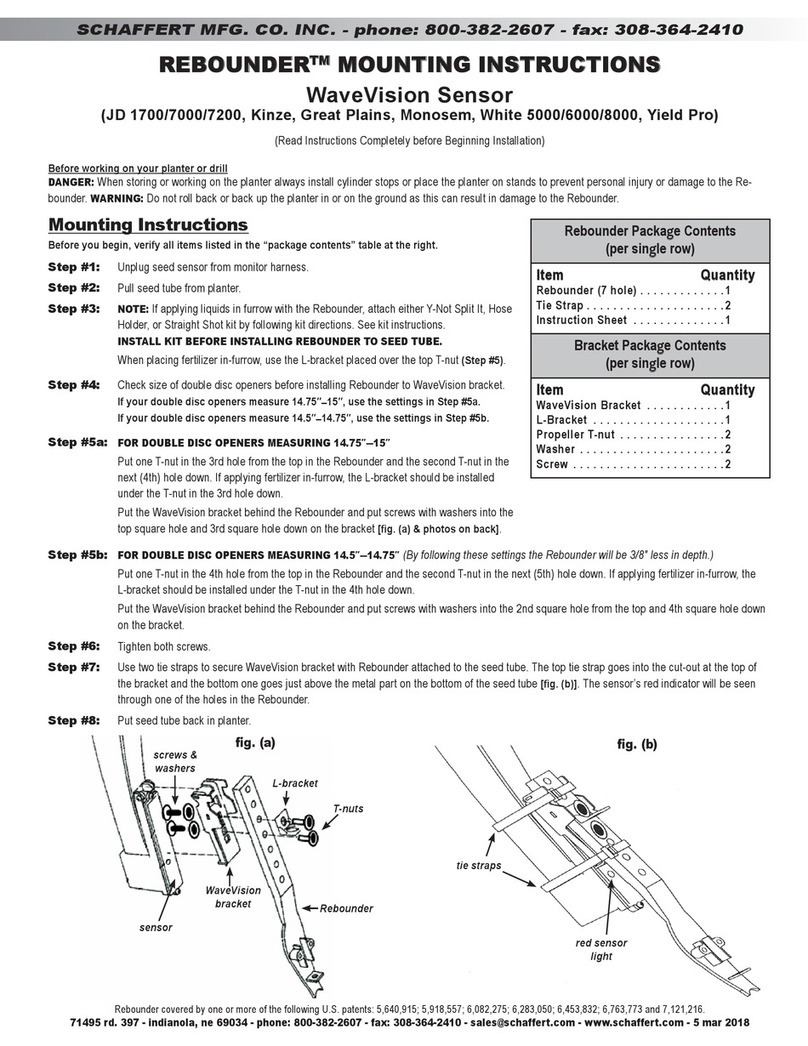
Schaffert
Schaffert Rebounder Mounting instructions

Stocks AG
Stocks AG Fan Jet Pro Plus 65 Original Operating Manual and parts list
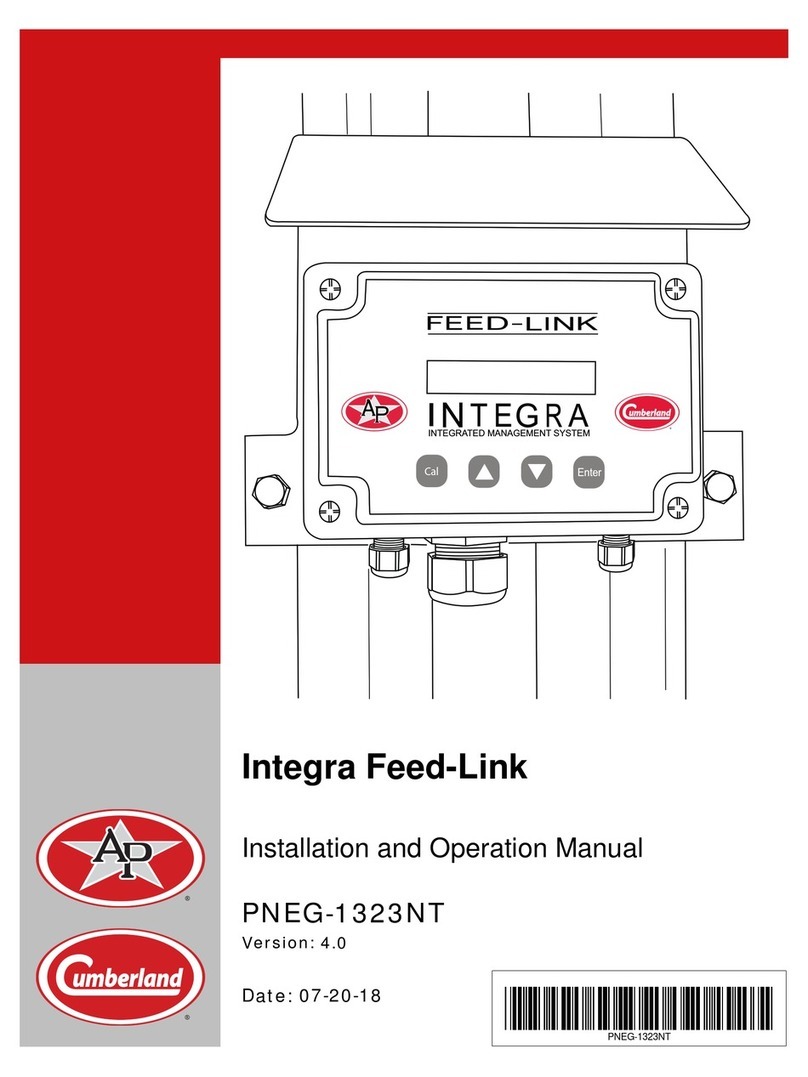
Cumberland
Cumberland Integra Feed-Link Installation and operation manual
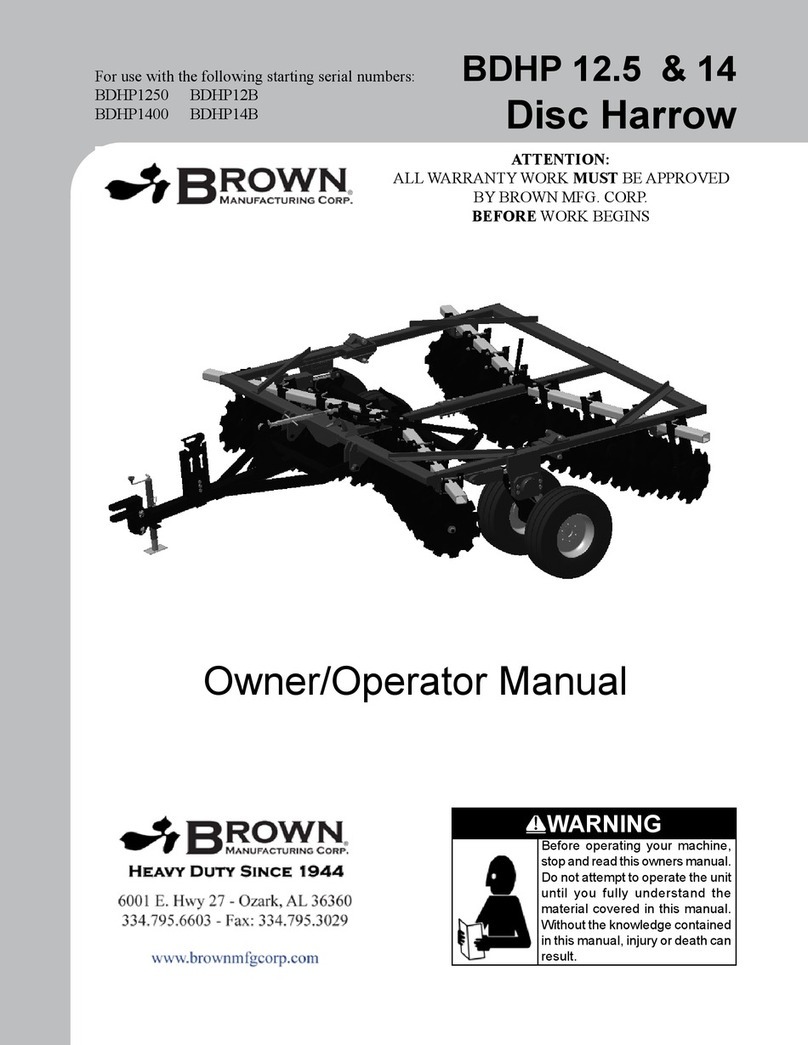
BROWN
BROWN BDHP-1250 Owner's/operator's manual
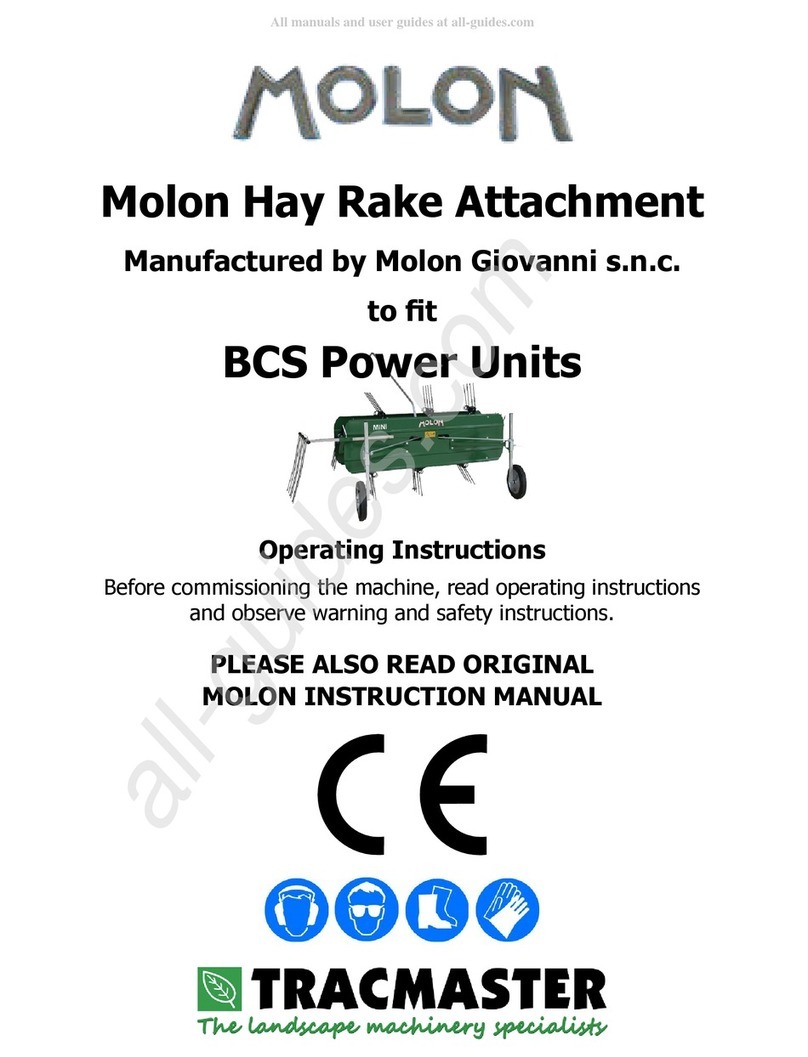
Molon
Molon BCS operating instructions
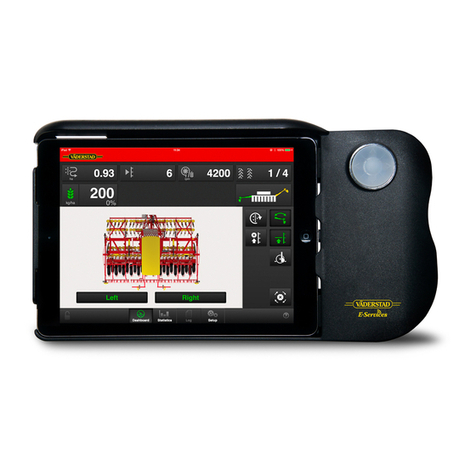
Vaderstad
Vaderstad Rapid Series instructions
